New Zealand v England
At Christchurch, March 13, 14, 15, 16. England won by 98 runs. Toss: New Zealand. Test debut: I. G. Butler.
|
|

|
A cricket ball had perhaps never been hit so cleanly, so often. Astle's first hundred had come from a brisk 114 deliveries, but he was merely playing himself in. The carnage began in earnest when Hussain took the second new ball: the next four overs, even though they included a wicket maiden from Caddick, yielded 61 runs. Hoggard, unplayable on the second day, was smashed for 41 in two overs - and out of the attack. So Astle turned his attention to Caddick, steaming in with the confidence of a man who had already grabbed six wickets in the innings. But in seven balls spread across two overs, Astle sprayed graffiti all over Caddick's figures by smacking him for 38. One six flew over third man, another landed on the roof of the stand at extra cover, and three more - over cover, mid-wicket, and straight down the ground - came in successive deliveries as the home sections of the crowd began to sing and dance in disbelief. England's supporters, so raucous moments before, were stunned into silence.
Another six off Flintoff, a gentle sweep for a single off Giles, and Astle had raced from 101 to 200 in a scarcely believable 39 balls. He reached his maiden Test double-century in 153, smashing the record - set by Adam Gilchrist at Johannesburg just three weeks earlier - by 59 deliveries. He had taken 217 minutes, three more than Bradman at Leeds in 1930, when the balls were not totted up (but over-rates were generally higher). It was as though Astle had taken two seconds off the 100 metres record.
Two more sixes off Hoggard followed, bringing the deficit down to double figures. England were seriously worried, and Astle later admitted he would have started to look for ones and twos had New Zealand come within 70 runs of victory. So the relief England felt when Astle drove at Hoggard and was caught behind for 222 was palpable. In all, he faced 168 balls in 231 minutes, hitting 28 fours and 11 sixes. He put on 118 with Cairns (in 69 balls), beating his own last-wicket record against England, an unbroken 106 with Danny Morrison at Auckland in 1996-97, and helped New Zealand to the second-highest total in the fourth innings of a Test, bettered only by England's 654 for five against South Africa at Durban in 1938-39. And he had done it all in the twinkling of an eye.
Amid the fireworks, it was easy to forget the mistake Astle made at a critical moment in England's second innings. With wickets falling regularly, Thorpe, on four, edged Drum to second slip, but Astle was unable to cling on. Soon after, England had lurched to 106 for five, leading by a precarious 187. But Thorpe survived, and he and Flintoff embarked on a stand that changed the course of the match.
Flintoff had managed just eight runs in his previous five Test innings, but within 13 deliveries a burst of searing cuts and drives had taken him to 26. The fifty partnership came in 39 balls, and New Zealand, deprived of Cairns, who had injured his right knee while bowling on the first day, began to wilt. England's lead was a seemingly impregnable 370 by the time Thorpe reached his third century in four Tests in New Zealand, from 121 balls. Flintoff, whose previous Test-best was 42, was even quicker, moving to his hundred from 114 balls with a top-edged hook over the keeper's head. The stand had reached 281, a sixth-wicket record for England, overtaking Peter Parfitt and Barry Knight's 240, also against New Zealand, at Auckland in 1962-63, when Flintoff picked out deep mid-wicket and departed for 137. Thorpe rattled on to a 231- ball double-hundred, his first in Tests and briefly the third-fastest in Test history, and finished with 28 fours and four sixes in five and a half hours. The ink had barely dried when Astle forced a rewrite.
The final two days, in which 856 runs were scored at almost five an over, provided a violent counterpoint to the first two, when 438 came at under three. On Lancaster Park's drop-in pitch, England lost two wickets in Cairns's first over. They were rescued by an innings of technical brilliance and masterful driving from Hussain, whose tenth Test hundred was flawed only by a straightforward chance to Fleming at first slip on 52.
Hussain's batting was matched by Hoggard's bowling. Swinging the ball as though playing on the green, green grass of Headingley, Hoggard bewitched New Zealand to claim a career-best seven for 63. Any chance of taking all ten was denied him by a characteristically late flash of inspiration by Caddick, who snapped up three wickets in one rampant over. When England lost five cheap wickets in their second innings, a close finish seemed inevitable - but the game was only just warming up.
Man of the Match: G. P. Thorpe.&

